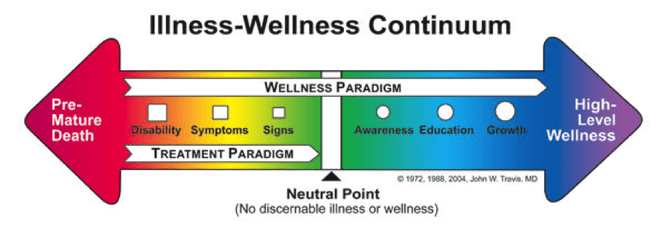The word “Wellness” is used by many people and organisations, especially since the sharp rise in healthcare costs, diabetes and obesity during the past decade. Wellness has a history of being defined within a disease framework, meaning reducing health risks and preventing disease. Those are good goals, but it’s an outdated vision. A new vision was articulated by a few innovators, including Wellness Inventory creator Dr. John Travis.
The Illness-Wellness Continuum illustrates the relationship of the treatment paradigm to the wellness paradigm. An individual can move beyond the “neutral” point to increasingly higher levels of wellness.
High-level wellness involves giving good care to your physical self, using your mind constructively, expressing your emotions effectively, being creatively involved with those around you, and being concerned about your physical, psychological and spiritual environments. In fact, it is less important where you are on the continuum; it’s more important which direction you're facing – toward illness or wellness.
High-level wellness doesn’t preclude periods of illness and weakness, nor does it attempt to deny that death is a natural part of life. We know that genetics and other factors can cause disease. High-level wellness simply defines choices we can make over things we can control in our life, including our behaviours.

